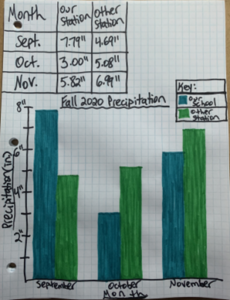Standards + Practices


Science Standards:
ESS.5.1.1 Analyze and interpret data to compare daily and seasonal changes in weather conditions and patterns
ESS.5.1.2 Analyze and interpret weather data to explain current and upcoming weather conditions in a given location
ESS.5.1.3 Construct an explanation to summarize the ocean’s influences on weather and climate in North Carolina
Science Practices
SP4: Analyze and interpret data
SP6: Constructing explanations
SP7: Engaging in argument from evidence
SP8: Obtaining, evaluating, and communicating information
Math Standards:
NC.5.MD.2 Represent and interpret data: Collect data by asking a question that yields data that changes over time.
NC.5.NBT.3 Read, write, and compare decimals to thousandths.
NC.5.NBT.7 Compute and solve real-world problems with multi-digit whole numbers and decimal numbers
Math Practices
MP2: Reason abstractly and quantitatively
MP5: Use appropriate tools strategically
MP6: Attending to precision
Resources + Supports

Ms. Clark’s Class Investigates Fall Rainfall
 Ms. Clark knew she needed to provide chances for her students to make sense of their data and the data from the other station, so she posed three questions that she wanted them to be sure to ask one another: 1) What patterns do I see in the data? 2) What are possible explanations for the data that stand out? and 3) What questions do I have? What data would help me to answer those questions? When Ms. Clark’s students start digging into the other station’s data, they are surprised by how similar their total precipitation for the meteorological fall season (September, October, November) is to the other station’s, and that their other station’s fall total is slightly greater. This finding refutes many students’ predictions that their total precipitation would be greater. Most students predicted that their school would have measured greater precipitation than the other station, because they are farther east (by about 80 miles). Students had thought that their more eastern location would mean more rain from tropical storms forming in the Atlantic Ocean. She wants to have her students collaborate to practice analyzing and interpreting data to help them construct explanations and arguments using their data as evidence for their claims.
Ms. Clark knew she needed to provide chances for her students to make sense of their data and the data from the other station, so she posed three questions that she wanted them to be sure to ask one another: 1) What patterns do I see in the data? 2) What are possible explanations for the data that stand out? and 3) What questions do I have? What data would help me to answer those questions? When Ms. Clark’s students start digging into the other station’s data, they are surprised by how similar their total precipitation for the meteorological fall season (September, October, November) is to the other station’s, and that their other station’s fall total is slightly greater. This finding refutes many students’ predictions that their total precipitation would be greater. Most students predicted that their school would have measured greater precipitation than the other station, because they are farther east (by about 80 miles). Students had thought that their more eastern location would mean more rain from tropical storms forming in the Atlantic Ocean. She wants to have her students collaborate to practice analyzing and interpreting data to help them construct explanations and arguments using their data as evidence for their claims.
Ms. Clark encourages students to look back in their notes from September through November to see what they had noted about precipitation. Consulting her notes, one student exclaims, “Remember in September? We had so much rain from Hurricane Sally!” Pointing to the graph that the class made of fall precipitation data, another student chimes in, “That’s right! Look! On September 18, we measured 2.25 inches!” Another student asks, “I wonder what the other station measured that day. Ms. Clark, can we ask them?” Ms. Clark responds, “We have these data because that station has had someone participating in CoCoRaHS just like us, so we can use the site to find out how much precipitation they measured on September 18th.” Ms. Clark demonstrates how to change the date on the interactive map on the CoCoRaHS website and displays the map for September 18th. The class finds the other station and discovers that they measured 1.81 inches that day.
At this point, students are excited to learn more about how the other station ended up with a fall total precipitation greater than theirs, especially when they measured less rain on a particular day. Ms. Clark divides the class into teams of 3, and assigns each team member a month: September, October, November. Each team member is responsible for taking a closer look at the daily precipitation data for their month. The resources that students can use for their investigation include: CoCoRaHS interactive map, CoCoRaHS Station Precipitation Summary, earlier weather reports, and news articles about tropical storm paths. The team members will then gather to share what they have found with one another.

Meteorological Seasons
Did you know that meteorologists and climatologists look at seasons differently than we do?
Meteorologists and climatologists use yearly temperature data to define seasons, whereas to others, seasons are defined astronomically, or by Earth’s position in relation to the sun. For the data students will be analyzing during this project, students will view seasons in the same way as meteorologists and climatologists view them in the Northern hemisphere, in three month cycles, based on temperature data:
- Summer: June, July, and August
- Fall: September, October, and November
- Winter: December, January, and February
- Spring: March, April and May.
For more information regarding this difference, please refer to the following informational page from NOAA: Meteorological vs. Astronomical Seasons
If interested in learning more about climatologists with your students, a list of climatologists and their contact information can be found on the website for the NC State Climate Office. The director of the State Climatologist office is a woman and this resource would be great to highlight diversity in a science field.

Place Value and Decimals
When students are working with multiple addends with decimals, remind them to keep place value in mind when writing the numbers. In order for the decimal points to line up, students may need to add zeros.
Also, students have been considering whether their daily measurements “make sense” given what they’ve observed in the weather. When students calculate monthly totals, it will also be useful for them to consider how reasonable their answer is. For example, they may compare the total with totals of other stations in their county.

Rainfall in Autumn
Be sure to clarify that “fall” is referring to the season (i.e., autumn) and not the precipitation, or rainfall, total.

Rainy Days Report
Daily county-level averages are available through the Rainy Days Report. Copying these values and pasting them into a spreadsheet will allow you to calculate an average monthly total. Students will be using the same strategy later in the year when working with historical data.

Practice Overview: Analyzing and Interpreting Data
Analyzing and interpreting data involves organizing and graphing collected data and making sense of it (e.g., finding relationships, patterns, outliers). Various tools can be used in data analysis including spreadsheets, graphing tools, and analytical software. Observation and reasoning help scientists make predictions and form explanations based on the data.
The following video, intended for a teacher audience, provides additional information related to this practice. (0:00-2:55)
https://www.youtube.com/watch?v=9NkT-oYPkOA&feature=youtu.be
How can I help my students analyze and interpret data?
Some possible strategies include:
- Emphasizing the importance of and providing opportunities for students to organize and make sense of data they have collected.
- Teaching students how to use appropriate scientific tools such as Excel or Google sheets, and graphing and statistical software.
- Providing students with questions that help students attend to relevant parts of the data. See table below.
Questions for students to consider when interpreting data
- What do I notice about how these data are displayed?
- What information can be found in the headings of the data sheet, the graph title, or on the x- and y-axis of the graph?
- What patterns do I see in the data?
- Are there data that stand out? What are possible explanations for those points?
- Are there data missing?
- What can I infer based on these data?
- What predictions could I make based on these data?
- What questions do I have or what do I still need to figure out? What data would help me answer those questions?

Now that students have compared with another station in the same region, you will be using data from stations in different regions during next month’s activity. You will need to make sure you have their station numbers and are able to access their data on the CoCoRaHS website.


